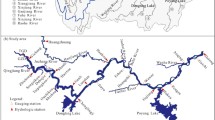Abstract
Rivers are one of the most important sources of water supply in the world. Reduction of water supply and resources reveals the necessity of investigation of water character changes. Construction of the Sattarkhan reservoir dam changed the morphological parameters such as stream velocity and sedimentary process of the Ahar Chai River. Identifying the changes of the river morphology is very important to avoid disasters in the future. In this paper, the morphology of the Ahar Chai River prior to the reservoir construction and changes of the river bed after the reservoir construction are studied and compared quantitatively. Two series of data of pre- and post-reservoir dam construction were collected from the hydrometric stations and field works. The annual sediment and water supply were estimated using daily measurement in hydrometric station and the HEC-RAS model was used to calculate the hydraulic parameters for each year using cross-sections. Cross-section forms depend on water discharge, slope, sediment supply, bed rock, etc. The investigations show that downstream of the reservoir is more eroded than the upstream after the reservoir dam construction and also exhibits a major decrease in the sediment supply. On the other hand, before the reservoir dam construction, there was a similar situation in all cross-sections; however, downstream is more affected and all parameters are totally moderated after the reservoir dam construction.





Similar content being viewed by others
References
AL-Ansari NA, Rimawi O (1997) The influence of the Mosul dam on the bed sediments and morphology of the River Tigris. Human impact on erosion and sedimentation, IAHS Publ.no. 245
Brandt SA (2000) Classification of geomorphological effects downstream of dams. Institute of Geography, University of Copenhagen, Øster Voldgade 10, DK-1350 Copenhagen, Denmark. pii:S0341-8162 00 00093-X
Burroughs B, Hayes D (2007) The rehabilitation potential of dam removal: temporal perspective from Michigan’s past dam removals. Department of fisheries &wildlife Michigan state university, 13 natural resources, East Lansing, MI 48824-1222
Friedman JM, Osterkamp WR, Scott ML, Auble GT (1998) Downstream effects of dams on channel geometry and bottomland vegetation: regional patterns in the Great Plains. Wetlands 18(4):619–633
Gordon E, Meentemeyer RK (2006) Effects of dam operation and land use on stream channel morphology and riparian vegetation. Elsevier, Amsterdam. doi:10.1016/j.geomorph.2006.06.001
Graf WL (2006) Downstream hydrologic and geomorphic effects of large dams on American rivers. See front matter© 2006 Elsevier B.V. All rights reserved. doi:10.1016/j.geomorph.2006.06.022
Grant GE (2012) The Geomorphic response of Gravel-bed rivers to dams: perspectives and prospects. Gravel-bed rivers: processes, tools, environments, first edn. Wiley, Hoboken
Grant GE, Schmidt JC, Lewis SL (2003) A geological framework for interpreting downstream effects of dams on rivers. A unique river, water science and application 7, Copyright by the American geophysical union, 10/1029/007WS13
King J (2002) Dams and environmental flow requirements. Design and rehabilitation of dams, SANCOLD course. University of Stellenbosch, Stellenbosch
Kondolf GM (1997) Hungry water: effects of dams and gravel mining on river channels. Department of landscape architecture and environmental planning, University of California, Berkeley, California 94720, USA. Environ Manag 21(4):533–551
Lane EW (1955) The importance of fluvial morphology in hydraulic engineering. In: Proceedings of the American Society of Civil Engineering, vol 81, paper 745, pp 1–17
Marston RA, Mills DJ, Wrazien DR, Bassett B, Splinter DK (2005) Effects of Jackson Lake dam on the Snake river and its floodplain, Grand Teton national park, Wyoming, USA. Elsevier, Amsterdam. doi:10.1016/j.geomorph.2005.03.005
Murle U, Ortlepp J, Zahner M (2003) Effects of experimental flooding on riverine morphology, structure and riparian vegetation: the river Spol, Swiss national park. doi:10.1007/s00027-003-0665-6
Petts GE (1987) Time-scales for ecological change in regulated rivers. In: Craig JF, Kemper JB (eds) Regulated Streams. Advances in ecology. Plenum, New York, pp 257–266
Richard G, Julien P (2004) Dam impacts on and restoration of an alluvial river—Rio Grande, New Mexico. Department of physical and environmental sciences, Mesa state college, Grand junction co, USA. Int J Sediment Res 18(2):89–96
Richards KS (1985) Equilibrium. In: Goudie A (ed) The encyclopedic dictionary of physical geography. Blackwell, Oxford, pp 163–164
Author information
Authors and Affiliations
Corresponding author
Rights and permissions
About this article
Cite this article
Ashouri, M., Piry, Z. & Rezaei Moghaddam, M.H. A comparison of the influence of the Sattarkhan reservoir dam on the upstream and downstream of the Ahar Chai River, NW Iran. Environ Earth Sci 73, 4099–4108 (2015). https://doi.org/10.1007/s12665-014-3695-6
Received:
Accepted:
Published:
Issue Date:
DOI: https://doi.org/10.1007/s12665-014-3695-6




